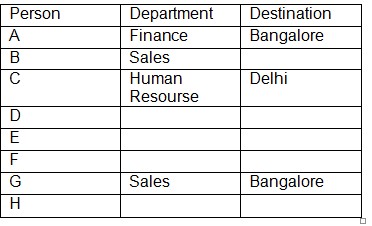Question
Which of the following city is visited by D?
Study the below details and answer the following questions. Eight persons – A, B, C, D, E, F, G and H are going to four destinations viz., Delhi, Bangalore, Mumbai and Kolkata and they represent four different departments viz., Human Resources, Sales, Finance and Marketing but not necessarily in the same order. At least two persons belong to the same department and two of them visit the same destination. A belongs to the Finance department and he visits the same city as that of G. G doesn’t belong to the Finance, Marketing or Human Resources department. G doesn’t visit Kolkata or Mumbai. C visits Delhi and belongs to Human Resources department. The person who belongs to the Finance department other than A visits Delhi. B and G belongs to the same department. F visits Mumbai and he, doesn’t belongs to Sales and Marketing department. The two persons who belong to Marketing department visit Kolkata. D doesn’t belong to the Marketing department.Solution
A belongs to the Finance department and he visits the same city as that of G. G doesn’t visit Kolkata or Mumbai. So, he visits either Delhi or Bangalore.  G doesn’t belong to the Finance, Marketing or Human Resources department. So, he belongs to Sales department.
G doesn’t belong to the Finance, Marketing or Human Resources department. So, he belongs to Sales department.  C visits Delhi and belongs to Human Resource department. Given, two persons visit same destination. So, A and G should travel to Bangalore.
C visits Delhi and belongs to Human Resource department. Given, two persons visit same destination. So, A and G should travel to Bangalore.  B and G belongs to the same department. So, B belongs to Sales department.
B and G belongs to the same department. So, B belongs to Sales department.  F visits Mumbai and he doesn’t belongs to Sales and Marketing department. So, he belongs to either Human Resources or Finance.
F visits Mumbai and he doesn’t belongs to Sales and Marketing department. So, he belongs to either Human Resources or Finance.  The two persons who belong to Marketing department visit Kolkata. D doesn’t belong to the Marketing department. Therefore, E and H belong to Marketing department and visit Kolkata.
The two persons who belong to Marketing department visit Kolkata. D doesn’t belong to the Marketing department. Therefore, E and H belong to Marketing department and visit Kolkata.  The person who belongs to the Finance department other than A visits Delhi. So, F belongs Human Resources. Therefore, D belongs to Finance and visits Delhi. B travel to Mumbai. The final arrangement will be as shown:
The person who belongs to the Finance department other than A visits Delhi. So, F belongs Human Resources. Therefore, D belongs to Finance and visits Delhi. B travel to Mumbai. The final arrangement will be as shown: 
Consider the following statements:
Statement (A): The open system refers to the flow of energy and materials in the environment.
Statement...
With which Indian firm Israel's Phinergy has signed a joint venture deal to produce metal-air batteries?
Name the leader who has the maximum number of followers on Twitter.
In mirrors the back surface is coated with a thin layer of
Where is Denali, previously known as Mount McKinley, located?
The GIS-based software developed by NHAI aims to monitor traffic at how many toll plazas initially?
The Indravati National Park (INP) is situated in ____________ .
Which of the following are part of Current Account transaction of BoP?
Which state received USESCO award of Merit for its preservation effort of iconic Srirangam Ranganathaswamy temple ?
Match the following-
Relevant for Exams:


